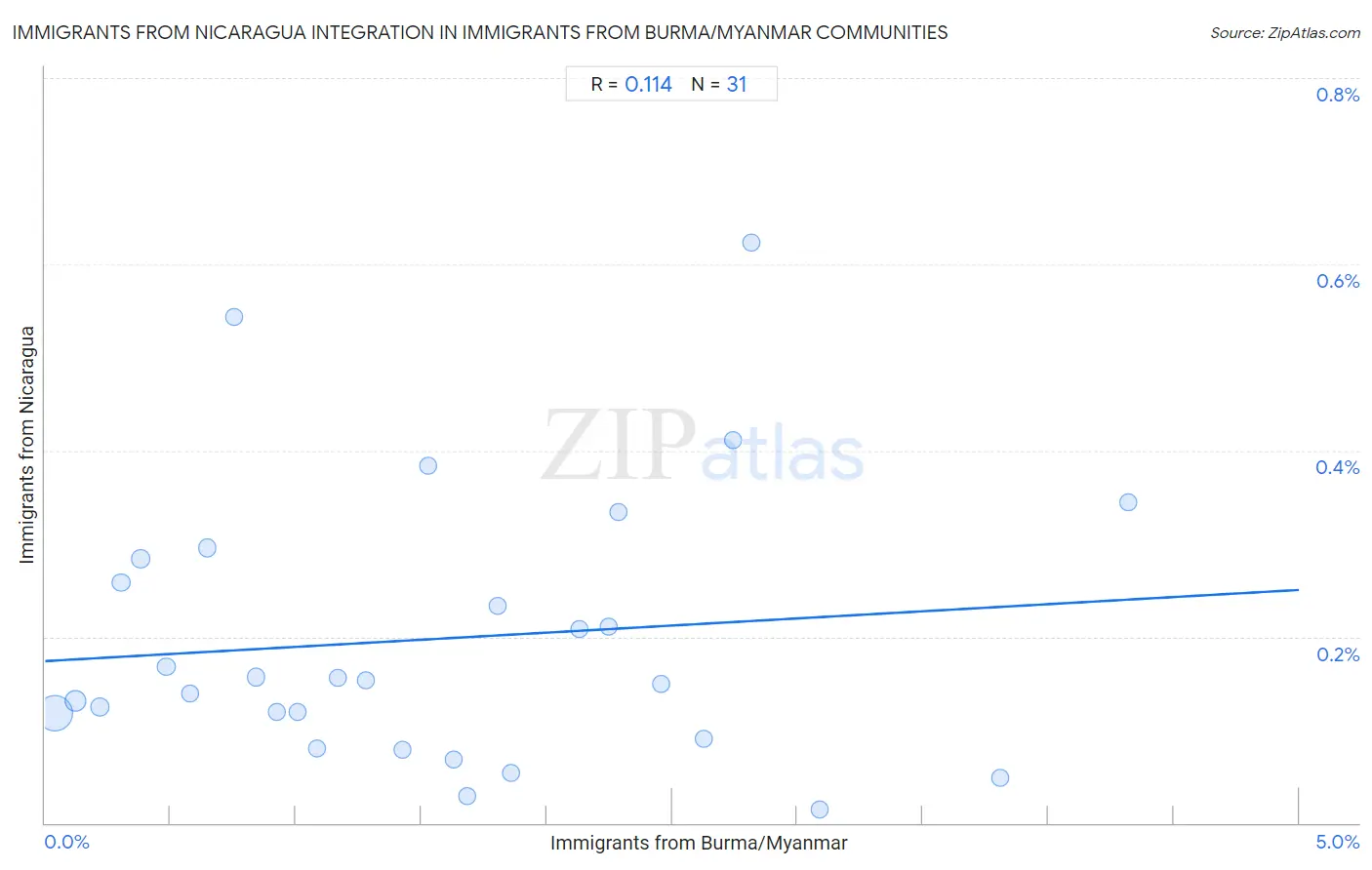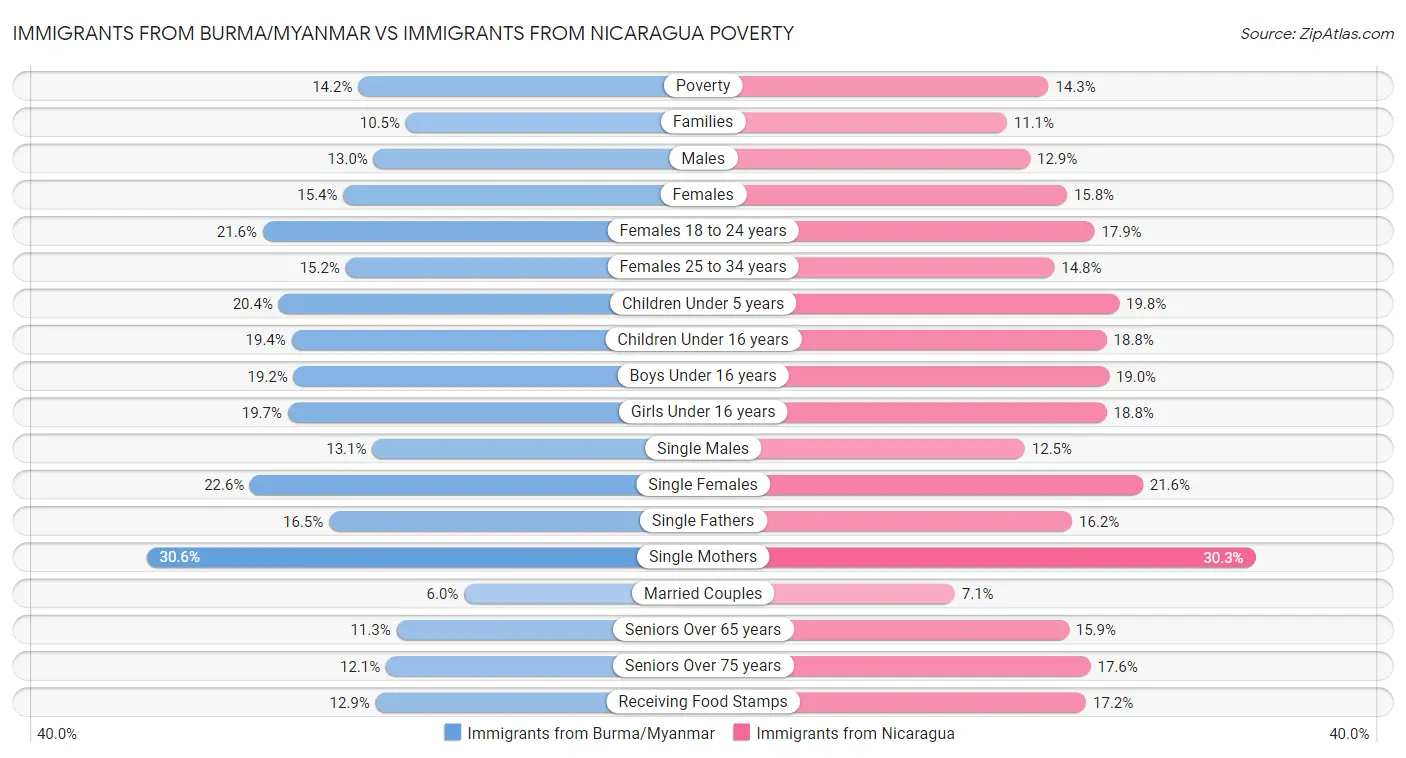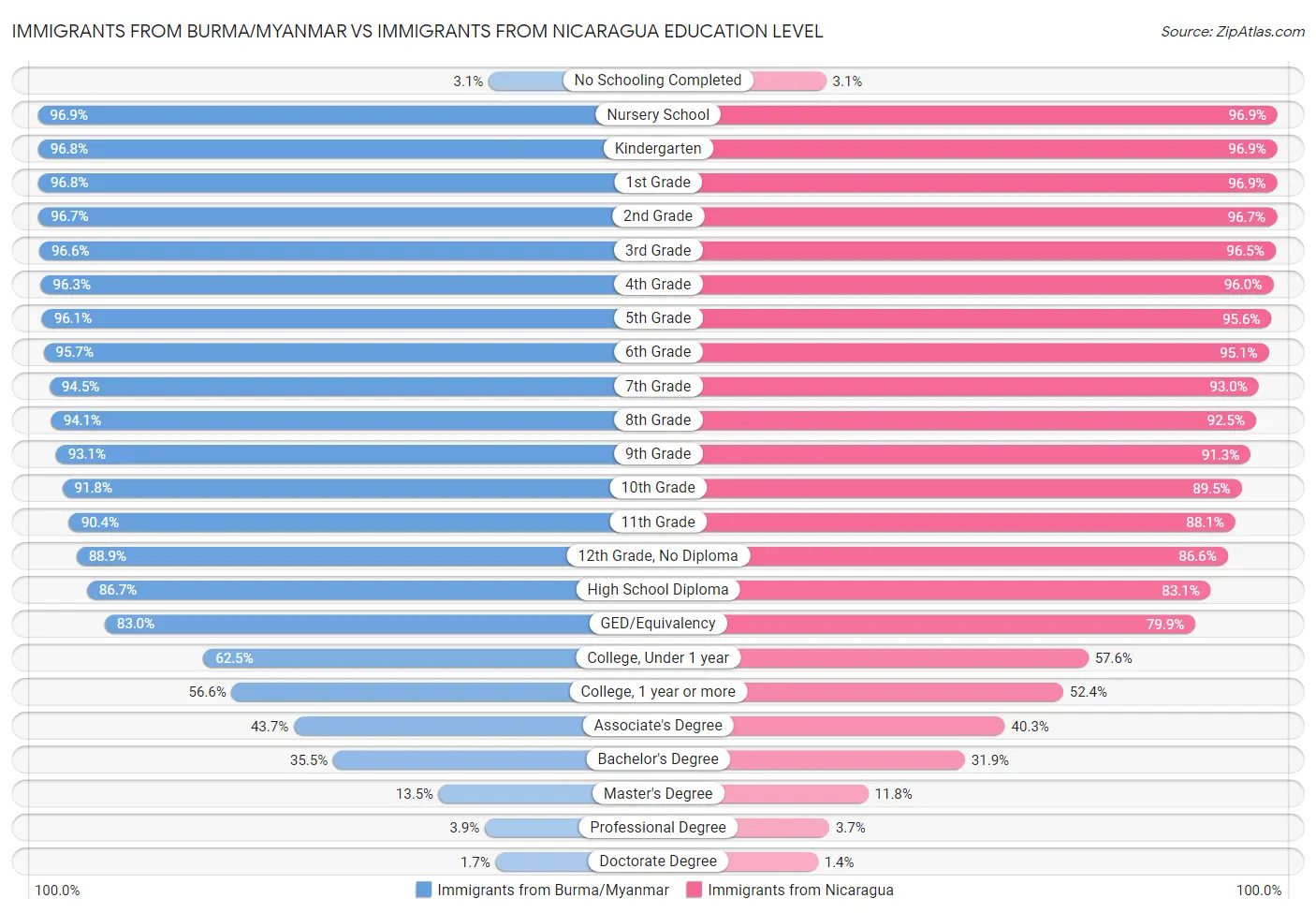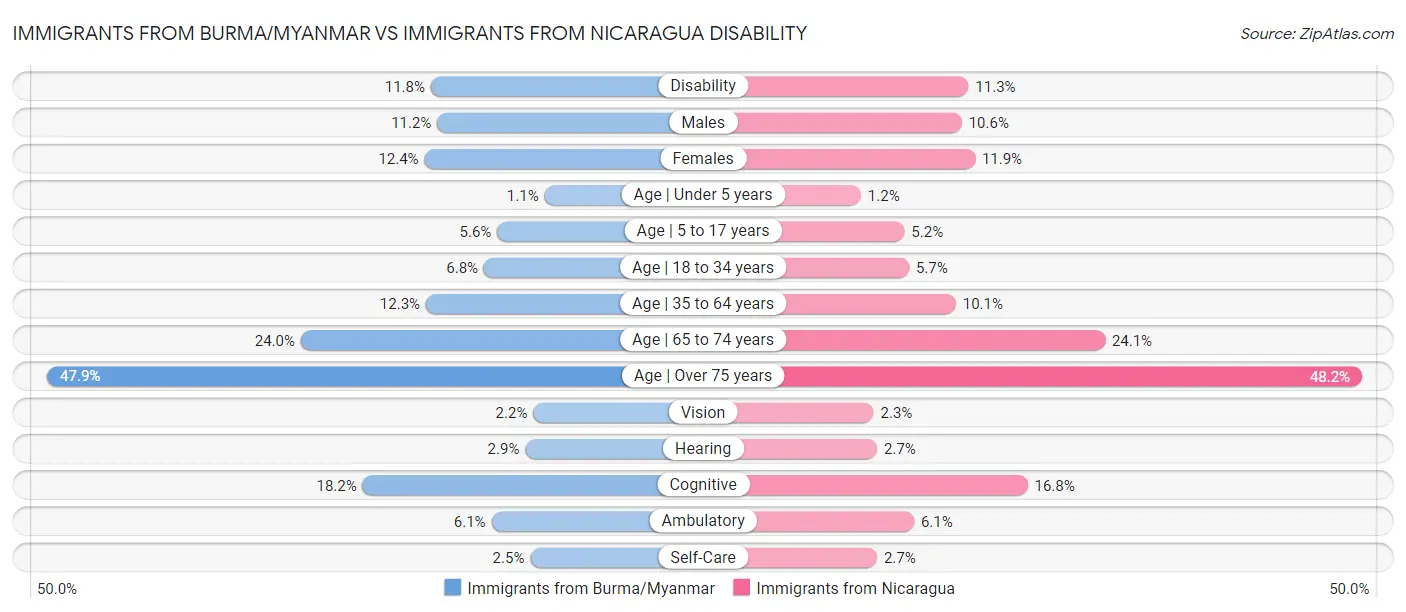Immigrants from Burma/Myanmar vs Immigrants from Nicaragua Community Comparison
COMPARE
Immigrants from Burma/Myanmar
Immigrants from Nicaragua
Social Comparison
Social Comparison
Immigrants from Burma/Myanmar
Immigrants from Nicaragua
3,365
SOCIAL INDEX
31.2/ 100
SOCIAL RATING
222nd/ 347
SOCIAL RANK
3,407
SOCIAL INDEX
31.6/ 100
SOCIAL RATING
221st/ 347
SOCIAL RANK
Immigrants from Nicaragua Integration in Immigrants from Burma/Myanmar Communities
The statistical analysis conducted on geographies consisting of 123,248,905 people shows a poor positive correlation between the proportion of Immigrants from Nicaragua within Immigrant from Burma/Myanmar communities in the United States with a correlation coefficient (R) of 0.114. On average, for every 1% (one percent) increase in Immigrants from Burma/Myanmar within a typical geography, there is an increase of 0.015% in Immigrants from Nicaragua. To illustrate, in a geography comprising of 100,000 individuals, a rise of 1,000 Immigrants from Burma/Myanmar corresponds to an increase of 15.3 Immigrants from Nicaragua.

Immigrants from Burma/Myanmar vs Immigrants from Nicaragua Income
When considering income, the most significant differences between Immigrants from Burma/Myanmar and Immigrants from Nicaragua communities in the United States are seen in householder income over 65 years ($57,114 compared to $52,085, a difference of 9.7%), householder income under 25 years ($48,749 compared to $53,266, a difference of 9.3%), and median family income ($94,472 compared to $88,267, a difference of 7.0%). Conversely, both communities are more comparable in terms of wage/income gap (22.8% compared to 23.0%, a difference of 0.62%), householder income ages 25 - 44 years ($86,736 compared to $84,914, a difference of 2.1%), and median household income ($78,682 compared to $76,784, a difference of 2.5%).

| Income Metric | Immigrants from Burma/Myanmar | Immigrants from Nicaragua |
| Per Capita Income | Tragic $39,827 | Tragic $38,065 |
| Median Family Income | Tragic $94,472 | Tragic $88,267 |
| Median Household Income | Tragic $78,682 | Tragic $76,784 |
| Median Earnings | Tragic $43,998 | Tragic $41,737 |
| Median Male Earnings | Tragic $50,298 | Tragic $47,482 |
| Median Female Earnings | Tragic $38,028 | Tragic $36,023 |
| Householder Age | Under 25 years | Tragic $48,749 | Exceptional $53,266 |
| Householder Age | 25 - 44 years | Tragic $86,736 | Tragic $84,914 |
| Householder Age | 45 - 64 years | Tragic $91,385 | Tragic $89,108 |
| Householder Age | Over 65 years | Tragic $57,114 | Tragic $52,085 |
| Wage/Income Gap | Exceptional 22.8% | Exceptional 23.0% |
Immigrants from Burma/Myanmar vs Immigrants from Nicaragua Poverty
When considering poverty, the most significant differences between Immigrants from Burma/Myanmar and Immigrants from Nicaragua communities in the United States are seen in seniors poverty over the age of 75 (12.1% compared to 17.6%, a difference of 45.8%), seniors poverty over the age of 65 (11.3% compared to 15.9%, a difference of 41.3%), and receiving food stamps (12.9% compared to 17.2%, a difference of 34.0%). Conversely, both communities are more comparable in terms of single mother poverty (30.6% compared to 30.3%, a difference of 0.82%), male poverty (13.0% compared to 12.9%, a difference of 0.86%), and poverty (14.2% compared to 14.3%, a difference of 0.91%).

| Poverty Metric | Immigrants from Burma/Myanmar | Immigrants from Nicaragua |
| Poverty | Tragic 14.2% | Tragic 14.3% |
| Families | Tragic 10.5% | Tragic 11.1% |
| Males | Tragic 13.0% | Tragic 12.9% |
| Females | Tragic 15.4% | Tragic 15.8% |
| Females 18 to 24 years | Tragic 21.6% | Exceptional 17.9% |
| Females 25 to 34 years | Tragic 15.2% | Tragic 14.8% |
| Children Under 5 years | Tragic 20.4% | Tragic 19.8% |
| Children Under 16 years | Tragic 19.4% | Tragic 18.8% |
| Boys Under 16 years | Tragic 19.2% | Tragic 19.0% |
| Girls Under 16 years | Tragic 19.7% | Tragic 18.8% |
| Single Males | Poor 13.1% | Excellent 12.5% |
| Single Females | Tragic 22.6% | Poor 21.6% |
| Single Fathers | Fair 16.5% | Good 16.2% |
| Single Mothers | Tragic 30.6% | Tragic 30.3% |
| Married Couples | Tragic 6.0% | Tragic 7.1% |
| Seniors Over 65 years | Fair 11.3% | Tragic 15.9% |
| Seniors Over 75 years | Good 12.1% | Tragic 17.6% |
| Receiving Food Stamps | Tragic 12.9% | Tragic 17.2% |
Immigrants from Burma/Myanmar vs Immigrants from Nicaragua Unemployment
When considering unemployment, the most significant differences between Immigrants from Burma/Myanmar and Immigrants from Nicaragua communities in the United States are seen in unemployment among women with children ages 6 to 17 years (7.5% compared to 9.6%, a difference of 27.7%), unemployment among ages 16 to 19 years (15.6% compared to 17.6%, a difference of 13.1%), and unemployment among ages 60 to 64 years (4.4% compared to 4.9%, a difference of 10.8%). Conversely, both communities are more comparable in terms of unemployment among ages 45 to 54 years (4.4% compared to 4.4%, a difference of 0.69%), male unemployment (5.2% compared to 5.1%, a difference of 1.7%), and unemployment among women with children under 6 years (7.3% compared to 7.2%, a difference of 2.1%).

| Unemployment Metric | Immigrants from Burma/Myanmar | Immigrants from Nicaragua |
| Unemployment | Excellent 5.1% | Average 5.2% |
| Males | Good 5.2% | Exceptional 5.1% |
| Females | Exceptional 5.1% | Poor 5.4% |
| Youth < 25 | Exceptional 10.6% | Exceptional 11.2% |
| Age | 16 to 19 years | Exceptional 15.6% | Average 17.6% |
| Age | 20 to 24 years | Exceptional 9.1% | Exceptional 9.7% |
| Age | 25 to 29 years | Exceptional 6.2% | Excellent 6.4% |
| Age | 30 to 34 years | Exceptional 5.1% | Fair 5.5% |
| Age | 35 to 44 years | Good 4.6% | Excellent 4.5% |
| Age | 45 to 54 years | Exceptional 4.4% | Exceptional 4.4% |
| Age | 55 to 59 years | Exceptional 4.4% | Good 4.8% |
| Age | 60 to 64 years | Exceptional 4.4% | Fair 4.9% |
| Age | 65 to 74 years | Exceptional 4.8% | Exceptional 5.1% |
| Seniors > 65 | Exceptional 4.6% | Exceptional 4.9% |
| Seniors > 75 | Exceptional 7.7% | Exceptional 7.9% |
| Women w/ Children < 6 | Exceptional 7.3% | Exceptional 7.2% |
| Women w/ Children 6 to 17 | Exceptional 7.5% | Tragic 9.6% |
| Women w/ Children < 18 | Good 5.4% | Tragic 5.7% |
Immigrants from Burma/Myanmar vs Immigrants from Nicaragua Labor Participation
When considering labor participation, the most significant differences between Immigrants from Burma/Myanmar and Immigrants from Nicaragua communities in the United States are seen in in labor force | age 16-19 (39.0% compared to 31.6%, a difference of 23.5%), in labor force | age 20-24 (76.3% compared to 72.9%, a difference of 4.7%), and in labor force | age 25-29 (84.7% compared to 82.9%, a difference of 2.1%). Conversely, both communities are more comparable in terms of in labor force | age 35-44 (84.0% compared to 84.1%, a difference of 0.080%), in labor force | age 20-64 (79.7% compared to 79.3%, a difference of 0.41%), and in labor force | age 45-54 (82.0% compared to 82.7%, a difference of 0.83%).

| Labor Participation Metric | Immigrants from Burma/Myanmar | Immigrants from Nicaragua |
| In Labor Force | Age > 16 | Exceptional 66.3% | Average 65.1% |
| In Labor Force | Age 20-64 | Good 79.7% | Poor 79.3% |
| In Labor Force | Age 16-19 | Exceptional 39.0% | Tragic 31.6% |
| In Labor Force | Age 20-24 | Exceptional 76.3% | Tragic 72.9% |
| In Labor Force | Age 25-29 | Average 84.7% | Tragic 82.9% |
| In Labor Force | Age 30-34 | Average 84.7% | Tragic 83.9% |
| In Labor Force | Age 35-44 | Tragic 84.0% | Tragic 84.1% |
| In Labor Force | Age 45-54 | Tragic 82.0% | Average 82.7% |
Immigrants from Burma/Myanmar vs Immigrants from Nicaragua Family Structure
When considering family structure, the most significant differences between Immigrants from Burma/Myanmar and Immigrants from Nicaragua communities in the United States are seen in births to unmarried women (32.9% compared to 38.0%, a difference of 15.5%), single father households (2.4% compared to 2.7%, a difference of 9.7%), and divorced or separated (12.1% compared to 13.3%, a difference of 9.6%). Conversely, both communities are more comparable in terms of family households with children (28.0% compared to 28.2%, a difference of 0.52%), currently married (44.3% compared to 43.7%, a difference of 1.3%), and average family size (3.29 compared to 3.37, a difference of 2.4%).

| Family Structure Metric | Immigrants from Burma/Myanmar | Immigrants from Nicaragua |
| Family Households | Tragic 62.6% | Exceptional 67.5% |
| Family Households with Children | Exceptional 28.0% | Exceptional 28.2% |
| Married-couple Households | Tragic 43.4% | Tragic 44.5% |
| Average Family Size | Exceptional 3.29 | Exceptional 3.37 |
| Single Father Households | Poor 2.4% | Tragic 2.7% |
| Single Mother Households | Tragic 7.0% | Tragic 7.4% |
| Currently Married | Tragic 44.3% | Tragic 43.7% |
| Divorced or Separated | Fair 12.1% | Tragic 13.3% |
| Births to Unmarried Women | Poor 32.9% | Tragic 38.0% |
Immigrants from Burma/Myanmar vs Immigrants from Nicaragua Vehicle Availability
When considering vehicle availability, the most significant differences between Immigrants from Burma/Myanmar and Immigrants from Nicaragua communities in the United States are seen in 4 or more vehicles in household (6.2% compared to 6.8%, a difference of 8.7%), 3 or more vehicles in household (18.8% compared to 20.2%, a difference of 7.4%), and no vehicles in household (10.4% compared to 9.9%, a difference of 5.0%). Conversely, both communities are more comparable in terms of 1 or more vehicles in household (89.7% compared to 90.1%, a difference of 0.50%), 2 or more vehicles in household (53.9% compared to 55.4%, a difference of 2.7%), and no vehicles in household (10.4% compared to 9.9%, a difference of 5.0%).

| Vehicle Availability Metric | Immigrants from Burma/Myanmar | Immigrants from Nicaragua |
| No Vehicles Available | Average 10.4% | Good 9.9% |
| 1+ Vehicles Available | Average 89.7% | Good 90.1% |
| 2+ Vehicles Available | Tragic 53.9% | Average 55.4% |
| 3+ Vehicles Available | Poor 18.8% | Excellent 20.2% |
| 4+ Vehicles Available | Fair 6.2% | Exceptional 6.8% |
Immigrants from Burma/Myanmar vs Immigrants from Nicaragua Education Level
When considering education level, the most significant differences between Immigrants from Burma/Myanmar and Immigrants from Nicaragua communities in the United States are seen in doctorate degree (1.7% compared to 1.4%, a difference of 26.1%), master's degree (13.5% compared to 11.8%, a difference of 14.1%), and bachelor's degree (35.5% compared to 31.9%, a difference of 11.1%). Conversely, both communities are more comparable in terms of 2nd grade (96.7% compared to 96.7%, a difference of 0.010%), kindergarten (96.8% compared to 96.9%, a difference of 0.060%), and 1st grade (96.8% compared to 96.9%, a difference of 0.060%).

| Education Level Metric | Immigrants from Burma/Myanmar | Immigrants from Nicaragua |
| No Schooling Completed | Tragic 3.1% | Tragic 3.1% |
| Nursery School | Tragic 96.9% | Tragic 96.9% |
| Kindergarten | Tragic 96.8% | Tragic 96.9% |
| 1st Grade | Tragic 96.8% | Tragic 96.9% |
| 2nd Grade | Tragic 96.7% | Tragic 96.7% |
| 3rd Grade | Tragic 96.6% | Tragic 96.5% |
| 4th Grade | Tragic 96.3% | Tragic 96.0% |
| 5th Grade | Tragic 96.1% | Tragic 95.6% |
| 6th Grade | Tragic 95.7% | Tragic 95.1% |
| 7th Grade | Tragic 94.5% | Tragic 93.0% |
| 8th Grade | Tragic 94.1% | Tragic 92.5% |
| 9th Grade | Tragic 93.1% | Tragic 91.3% |
| 10th Grade | Tragic 91.8% | Tragic 89.5% |
| 11th Grade | Tragic 90.4% | Tragic 88.1% |
| 12th Grade, No Diploma | Tragic 88.9% | Tragic 86.6% |
| High School Diploma | Tragic 86.7% | Tragic 83.1% |
| GED/Equivalency | Tragic 83.0% | Tragic 79.9% |
| College, Under 1 year | Tragic 62.5% | Tragic 57.6% |
| College, 1 year or more | Tragic 56.6% | Tragic 52.4% |
| Associate's Degree | Tragic 43.7% | Tragic 40.3% |
| Bachelor's Degree | Tragic 35.5% | Tragic 31.9% |
| Master's Degree | Tragic 13.5% | Tragic 11.8% |
| Professional Degree | Tragic 3.9% | Tragic 3.7% |
| Doctorate Degree | Poor 1.7% | Tragic 1.4% |
Immigrants from Burma/Myanmar vs Immigrants from Nicaragua Disability
When considering disability, the most significant differences between Immigrants from Burma/Myanmar and Immigrants from Nicaragua communities in the United States are seen in disability age 35 to 64 (12.3% compared to 10.1%, a difference of 21.9%), disability age 18 to 34 (6.8% compared to 5.7%, a difference of 20.3%), and hearing disability (2.9% compared to 2.7%, a difference of 9.8%). Conversely, both communities are more comparable in terms of disability age 65 to 74 (24.0% compared to 24.1%, a difference of 0.27%), ambulatory disability (6.1% compared to 6.1%, a difference of 0.44%), and disability age over 75 (47.9% compared to 48.2%, a difference of 0.77%).

| Disability Metric | Immigrants from Burma/Myanmar | Immigrants from Nicaragua |
| Disability | Fair 11.8% | Exceptional 11.3% |
| Males | Average 11.2% | Exceptional 10.6% |
| Females | Poor 12.4% | Exceptional 11.9% |
| Age | Under 5 years | Exceptional 1.1% | Exceptional 1.2% |
| Age | 5 to 17 years | Average 5.6% | Exceptional 5.2% |
| Age | 18 to 34 years | Poor 6.8% | Exceptional 5.7% |
| Age | 35 to 64 years | Tragic 12.3% | Exceptional 10.1% |
| Age | 65 to 74 years | Poor 24.0% | Tragic 24.1% |
| Age | Over 75 years | Poor 47.9% | Tragic 48.2% |
| Vision | Fair 2.2% | Tragic 2.3% |
| Hearing | Good 2.9% | Exceptional 2.7% |
| Cognitive | Tragic 18.2% | Exceptional 16.8% |
| Ambulatory | Average 6.1% | Average 6.1% |
| Self-Care | Average 2.5% | Tragic 2.7% |